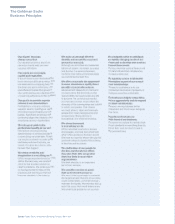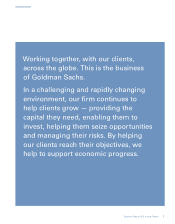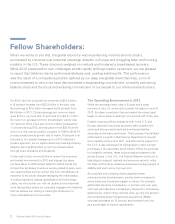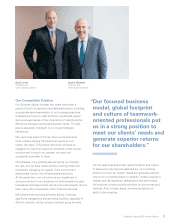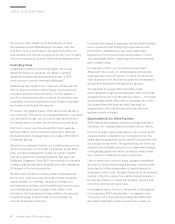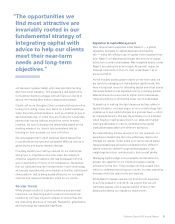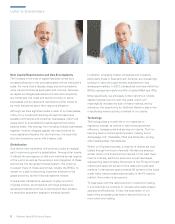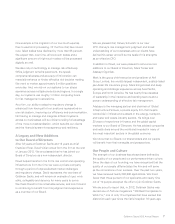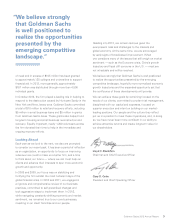Goldman Sachs 2012 Annual Report Download - page 8
Download and view the complete annual report
Please find page 8 of the 2012 Goldman Sachs annual report below. You can navigate through the pages in the report by either clicking on the pages listed below, or by using the keyword search tool below to find specific information within the annual report.
6Goldman Sachs 2012 Annual Report
In addition, emerging market companies and investors,
particularly those in Asia and Latin America, are increasingly
looking for value and opportunistic acquisitions in key
developed markets. In 2012, transactions volumes within the
BRICs represented nearly one-fifth of global M&A and IPOs.
More specifically, we anticipate further reforms in China’s
capital markets over the next five years, which will
meaningfully increase the size of these markets, and by
extension, the opportunity for Goldman Sachs to play a role
in facilitating market activity on behalf of our clients.
Technology
Technology plays a crucial role in our response to
regulatory change, as well as in optimizing operational
efficiency, managing risk and serving our clients. The firm
has long been a technological innovator, helping found
Archipelago, ICE, TradeWeb, FXaII and BrokerTec, among
other leading-edge marketplaces.
Within our Equities business, a majority of shares are now
traded through low-touch channels. We also are seeing a
similar trend in the fixed income markets. In the cash fixed
income markets, electronic execution is well developed,
representing approximately 80 percent of the FX spot forward
market and nearly 20 percent of the rates and credit cash
markets. In derivatives, approximately 50 percent of the liquid
credit index market trades electronically; in the FX options
market, the number is ten percent.
To keep pace with the rapid evolution in electronic trading,
it is critical that we continue to innovate and create greater
operational efficiencies. In fact, the automation of our
back-office processing has been a natural follow-on to
more electronic trading.
Letter to Shareholders
New Capital Requirements and Size & Complexity
The increase in the cost of capital has been joined by a
corresponding rise in the cost associated with an institution’s
scale. For more than a decade, larger size and complexity
were viewed entirely as synergistic and virtuous. However,
as capital surcharges associated with size and complexity
are introduced, the costs and barriers to entry in some
businesses will be raised and institutions will be forced to
be more disciplined about their resource allocation.
Although we have significant scale in each of our businesses,
many of our investment banking competitors also have
sizeable commercial and consumer businesses, which will
cause them to hold additional capital against their entire
balance sheet. Any synergy from housing multiple businesses
together must be weighed against the requirements for
more capital and liquidity. For the first time, it is clear that
size and complexity come with a higher cost.
Globalization
One theme that we believe will continue to play an integral
part in economic growth is globalization. Among other trends,
it reflects the emergence of vital new markets across regions
of the world, as well as the evolution and integration of these
economies into the global financial system. We continue
to expect many of these economies, notably the BRICs, to
remain on a path to becoming important anchors for the
global economy, as their financial systems mature.
Cross-border transactions represent roughly one-third
of global volume, as companies with large exposure to
developed markets continue to look beyond their borders
for attractive acquisition targets to enhance growth.


